实验3 OpenFlow协议分析实践
实验3 OpenFlow协议分时实践
基础实验
抓包分析
step1:搭建拓扑并配置相应IP
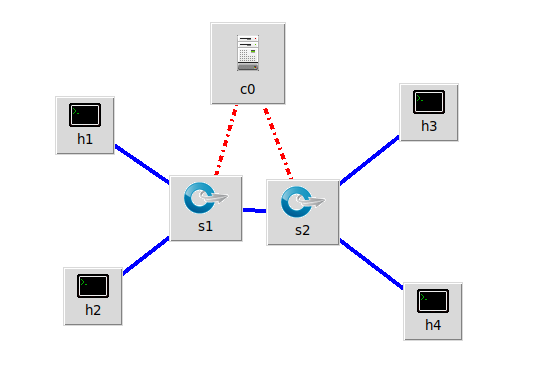
IP配置如下:
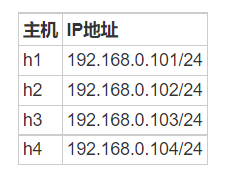
代码:
#!/usr/bin/env python
from mininet.net import Mininet
from mininet.node import Controller, RemoteController, OVSController
from mininet.node import CPULimitedHost, Host, Node
from mininet.node import OVSKernelSwitch, UserSwitch
from mininet.node import IVSSwitch
from mininet.cli import CLI
from mininet.log import setLogLevel, info
from mininet.link import TCLink, Intf
from subprocess import call
def myNetwork():
net = Mininet( topo=None,
build=False,
ipBase='192.168.0.0/24')
info( '*** Adding controller\n' )
c0=net.addController(name='c0',
controller=Controller,
protocol='tcp',
port=6633)
info( '*** Add switches\n')
s1 = net.addSwitch('s1', cls=OVSKernelSwitch)
s2 = net.addSwitch('s2', cls=OVSKernelSwitch)
info( '*** Add hosts\n')
h1 = net.addHost('h1', cls=Host, ip='192.168.0.101', defaultRoute=None)
h2 = net.addHost('h2', cls=Host, ip='192.168.0.102', defaultRoute=None)
h3 = net.addHost('h3', cls=Host, ip='192.168.0.103', defaultRoute=None)
h4 = net.addHost('h4', cls=Host, ip='192.168.0.104', defaultRoute=None)
info( '*** Add links\n')
net.addLink(h1, s1)
net.addLink(h3, s1)
net.addLink(s1, s2)
net.addLink(s2, h2)
net.addLink(s2, h4)
info( '*** Starting network\n')
net.build()
info( '*** Starting controllers\n')
for controller in net.controllers:
controller.start()
info( '*** Starting switches\n')
net.get('s1').start([c0])
net.get('s2').start([c0])
CLI(net)
net.stop()
if __name__ == '__main__':
setLogLevel( 'info' )
myNetwork()
step2:
Pingall并抓包
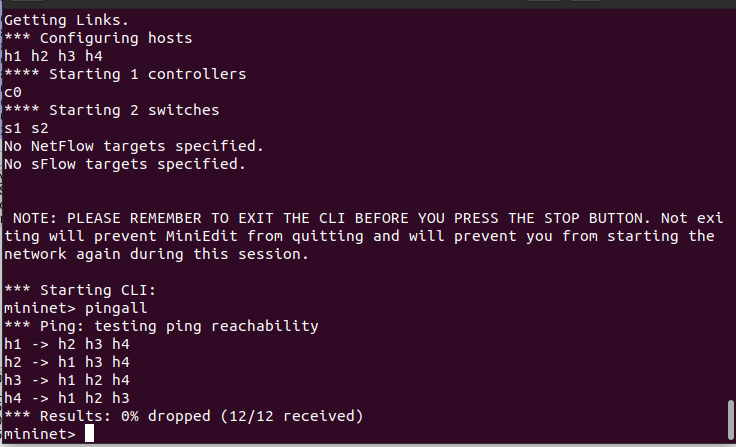
step3:分析
(1)hello包
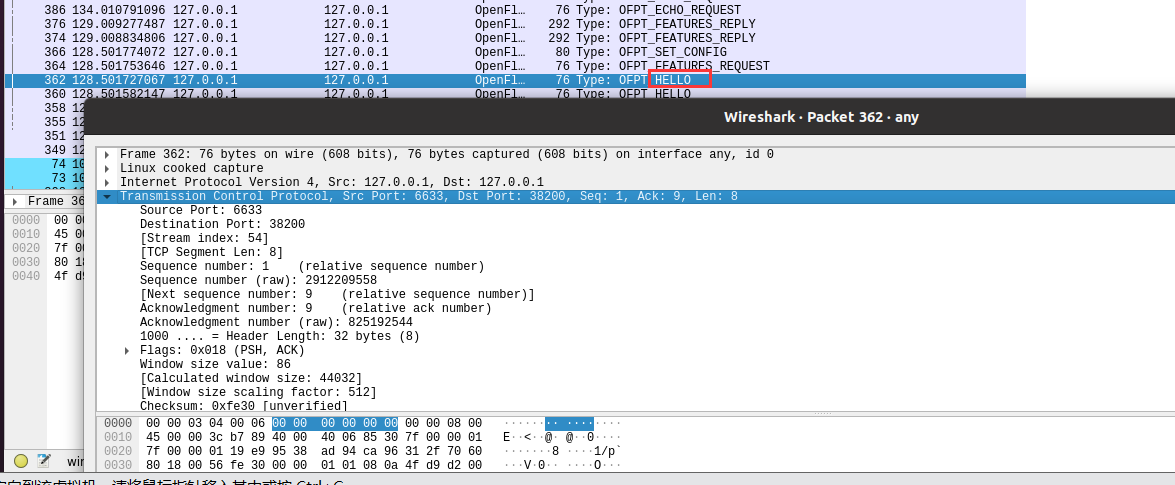
表示含义:控制器6633端口 发送“我最高能支持OpenFlow1.0”信息给交换机38200端口

表示含义:交换机端口38200发“我最高能支持OpenFlow1.0”信息给控制器的6633端口
于是双方建立连接,并使用OpenFlow1.0
(2)Feature_Request

表示含义:控制器6633端口发送“我需要你的特征信息”信息给交换机的38200端口
(3)Set_Config

表示含义:控制器6633端口发送信息“请按照我给你的Flag和Max_Bytes of Packet进行配置"信息给交换机的38200端口
(4)Feature_Reply
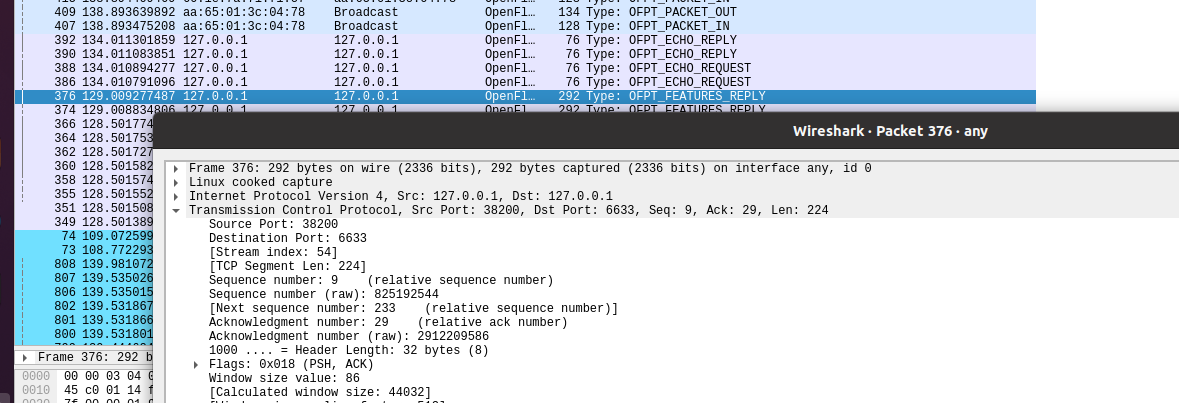
表示含义:交换机38200端口发送“这是我的特征信息,请查收”信息给控制器的6633端口
(5)Packet_in

表示含义:交换机38200端口发送“有数据包进入,请指示”信息给控制器的6633端口
(6)Packet_out

表示含义:控制器6633端口发送“请按照我给你的action进行处理”信息给交换机的38200端口
(7)Flow_Mod

表示含义:控制器通过6633端口向交换机38198端口下发流表项,指导数据的转发处理。
(8)Port_status
当交换机端口发生变化时,告知控制器相应的端口状态。
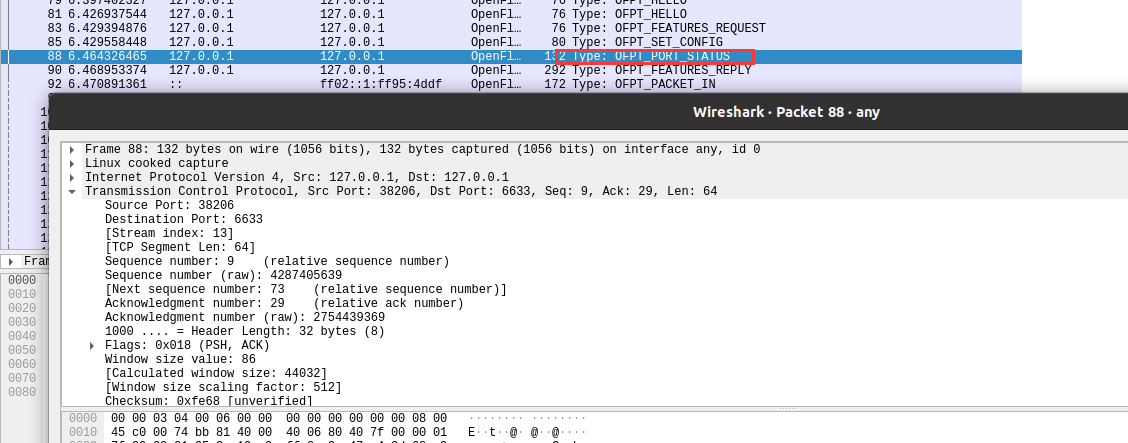

交互图

问题回答
交换机与控制器建立通信时是使用TCP协议还是UDP协议?
TCP协议
进阶要求
查看OpenFlow目录下的头文件
OpenFlow的数据包头通用字段
/* Header on all OpenFlow packets. */
struct ofp_header {
uint8_t version; /* OFP_VERSION. */
uint8_t type; /* One of the OFPT_ constants. */
uint16_t length; /* Length including this ofp_header. */
uint32_t xid; /* Transaction id associated with this packet.
Replies use the same id as was in the request
to facilitate pairing. */
};
物理描述端口
/* Description of a physical port */
struct ofp_phy_port {
uint16_t port_no;
uint8_t hw_addr[OFP_ETH_ALEN];
char name[OFP_MAX_PORT_NAME_LEN]; /* Null-terminated */
uint32_t config; /* Bitmap of OFPPC_* flags. */
uint32_t state; /* Bitmap of OFPPS_* flags. */
/* Bitmaps of OFPPF_* that describe features. All bits zeroed if
* unsupported or unavailable. */
uint32_t curr; /* Current features. */
uint32_t advertised; /* Features being advertised by the port. */
uint32_t supported; /* Features supported by the port. */
uint32_t peer; /* Features advertised by peer. */
};
交换机的特性
/* Switch features. */
struct ofp_switch_features {
struct ofp_header header;
uint64_t datapath_id; /* Datapath unique ID. The lower 48-bits are for
a MAC address, while the upper 16-bits are
implementer-defined. */
uint32_t n_buffers; /* Max packets buffered at once. */
uint8_t n_tables; /* Number of tables supported by datapath. */
uint8_t pad[3]; /* Align to 64-bits. */
/* Features. */
uint32_t capabilities; /* Bitmap of support "ofp_capabilities". */
uint32_t actions; /* Bitmap of supported "ofp_action_type"s. */
/* Port info.*/
struct ofp_phy_port ports[0]; /* Port definitions. The number of ports
is inferred from the length field in
the header. */
};
n_buffers表示交换机缓冲区可以
缓存的最大数据包个数
n_tables表示流表数量
pad作为一个填充值
capabilities表示支持的特殊功能
actions:表示支持的动作
port data表示物理端口描述列表
(1)hello
/* Header on all OpenFlow packets. */
struct ofp_header {
uint8_t version; /* OFP_VERSION. */
uint8_t type; /* One of the OFPT_ constants. */
uint16_t length; /* Length including this ofp_header. */
uint32_t xid; /* Transaction id associated with this packet.
Replies use the same id as was in the request
to facilitate pairing. */
};
OFP_ASSERT(sizeof(struct ofp_header) == 8);
/* OFPT_HELLO. This message has an empty body, but implementations must
* ignore any data included in the body, to allow for future extensions. */
struct ofp_hello {
struct ofp_header header;
};

(2)Feature Request
/* Switch features. */
struct ofp_switch_features {
struct ofp_header header;
uint64_t datapath_id; /* Datapath unique ID. The lower 48-bits are for
a MAC address, while the upper 16-bits are
implementer-defined. */
uint32_t n_buffers; /* Max packets buffered at once. */
uint8_t n_tables; /* Number of tables supported by datapath. */
uint8_t pad[3]; /* Align to 64-bits. */
/* Features. */
uint32_t capabilities; /* Bitmap of support "ofp_capabilities". */
uint32_t actions; /* Bitmap of supported "ofp_action_type"s. */
/* Port info.*/
struct ofp_phy_port ports[0]; /* Port definitions. The number of ports
is inferred from the length field in
the header. */
};
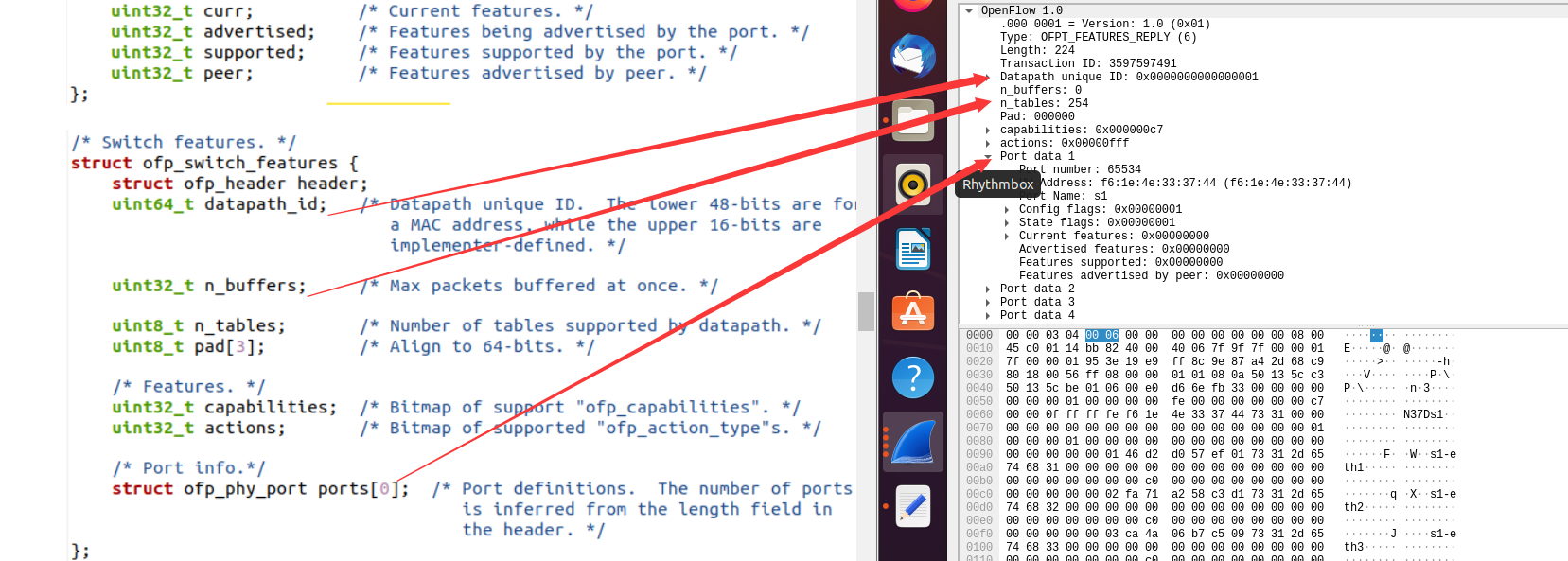
(3) Packet_in
/* Why is this packet being sent to the controller? */
enum ofp_packet_in_reason {
OFPR_NO_MATCH, /* No matching flow. */
OFPR_ACTION /* Action explicitly output to controller. */
};
/* Packet received on port (datapath -> controller). */
struct ofp_packet_in {
struct ofp_header header;
uint32_t buffer_id; /* ID assigned by datapath. */
uint16_t total_len; /* Full length of frame. */
uint16_t in_port; /* Port on which frame was received. */
uint8_t reason; /* Reason packet is being sent (one of OFPR_*) */
uint8_t pad;
uint8_t data[0]; /* Ethernet frame, halfway through 32-bit word,
so the IP header is 32-bit aligned. The
amount of data is inferred from the length
field in the header. Because of padding,
offsetof(struct ofp_packet_in, data) ==
sizeof(struct ofp_packet_in) - 2. */
};
有两种情况:
• 交换机查找流表,发现没有匹配条目时
• 有匹配条目但是对应的action是OUTPUT=CONTROLLER时
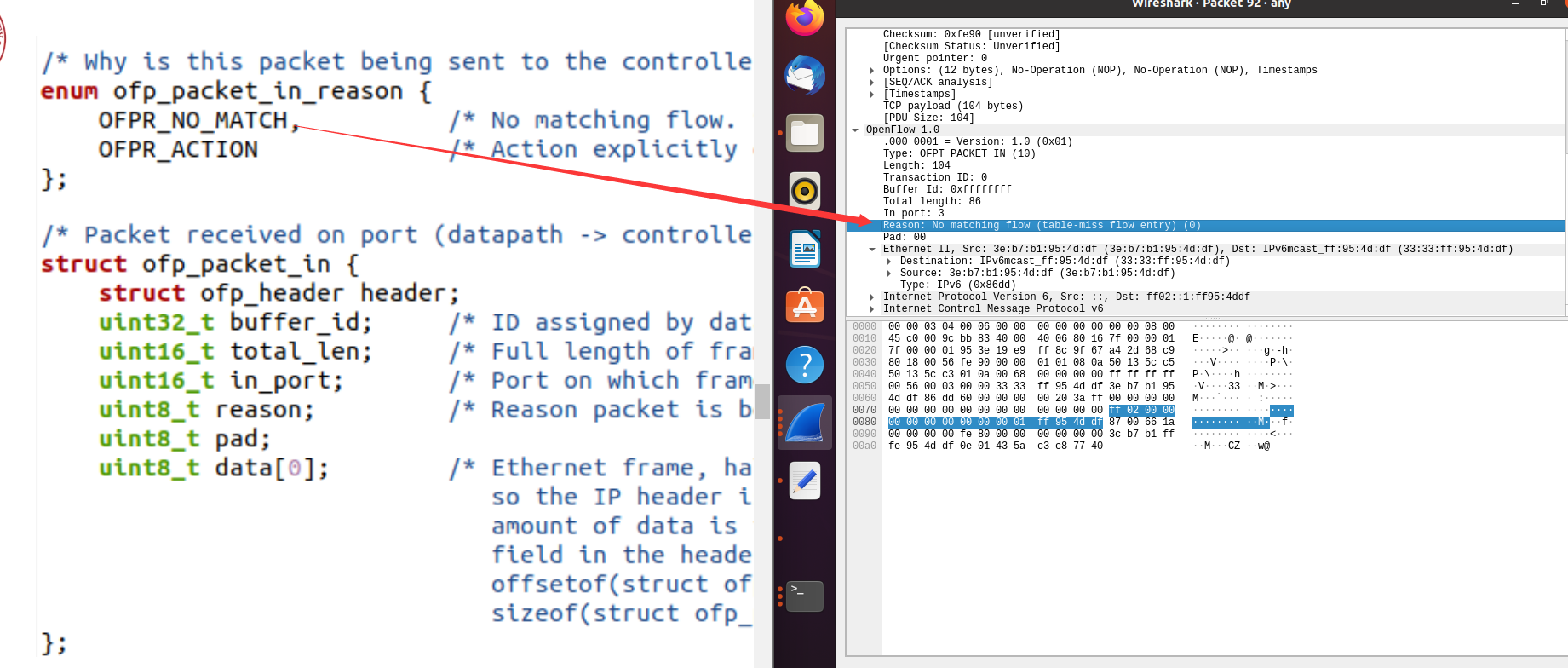
图中所示为交换机不知道如何处理数据包因而发送信息给控制器
(4)Flow_mod
/* Flow setup and teardown (controller -> datapath). */
struct ofp_flow_mod {
struct ofp_header header;
struct ofp_match match; /* Fields to match */
uint64_t cookie; /* Opaque controller-issued identifier. */
/* Flow actions. */
uint16_t command; /* One of OFPFC_*. */
uint16_t idle_timeout; /* Idle time before discarding (seconds). */
uint16_t hard_timeout; /* Max time before discarding (seconds). */
uint16_t priority; /* Priority level of flow entry. */
uint32_t buffer_id; /* Buffered packet to apply to (or -1).
Not meaningful for OFPFC_DELETE*. */
uint16_t out_port; /* For OFPFC_DELETE* commands, require
matching entries to include this as an
output port. A value of OFPP_NONE
indicates no restriction. */
uint16_t flags; /* One of OFPFF_*. */
struct ofp_action_header actions[0]; /* The action length is inferred
from the length field in the
header. */
};

(5)Packet_mod
/* Action header that is common to all actions. The length includes the
* header and any padding used to make the action 64-bit aligned.
* NB: The length of an action *must* always be a multiple of eight. */
struct ofp_action_header {
uint16_t type; /* One of OFPAT_*. */
uint16_t len; /* Length of action, including this
header. This is the length of action,
including any padding to make it
64-bit aligned. */
uint8_t pad[4];
};
OFP_ASSERT(sizeof(struct ofp_action_header) == 8);
/* Send packet (controller -> datapath). */
struct ofp_packet_out {
struct ofp_header header;
uint32_t buffer_id; /* ID assigned by datapath (-1 if none). */
uint16_t in_port; /* Packet's input port (OFPP_NONE if none). */
uint16_t actions_len; /* Size of action array in bytes. */
struct ofp_action_header actions[0]; /* Actions. */
/* uint8_t data[0]; */ /* Packet data. The length is inferred
from the length field in the header.
(Only meaningful if buffer_id == -1.) */
};
(6) Packet_out
"请按照我给你的action进行处理"
/* Action header that is common to all actions. The length includes the
* header and any padding used to make the action 64-bit aligned.
* NB: The length of an action *must* always be a multiple of eight. */
struct ofp_action_header {
uint16_t type; /* One of OFPAT_*. */
uint16_t len; /* Length of action, including this
header. This is the length of action,
including any padding to make it
64-bit aligned. */
uint8_t pad[4];
};
OFP_ASSERT(sizeof(struct ofp_action_header) == 8);
/* Send packet (controller -> datapath). */
struct ofp_packet_out {
struct ofp_header header;
uint32_t buffer_id; /* ID assigned by datapath (-1 if none). */
uint16_t in_port; /* Packet's input port (OFPP_NONE if none). */
uint16_t actions_len; /* Size of action array in bytes. */
struct ofp_action_header actions[0]; /* Actions. */
/* uint8_t data[0]; */ /* Packet data. The length is inferred
from the length field in the header.
(Only meaningful if buffer_id == -1.) */
};
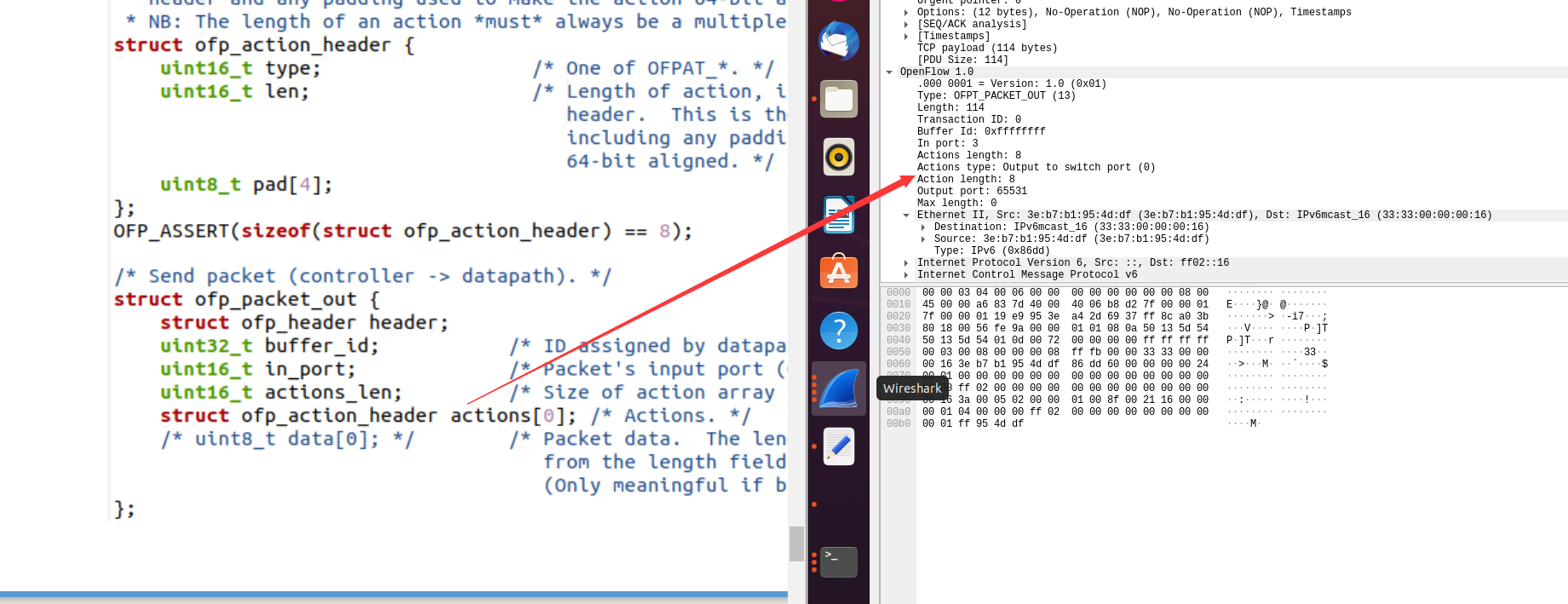
实验总结
(1)此次实验的整体过程
在OpenFlow1.3协议的情况下,控制器与OpenFlow交换机的消息完整交互流程如下:
1、 控制器与OpenFlow交换机通过TCP“三次握手”,建立有效的连接。其中,控制器一端的端口号为6633。
2、 控制器与OpenFlow交换机之间相互发送Hello消息,用于协商双方的OpenFlow版本号。在双方支持的最高版本号不一致的情况下,协商的结果将以较低的OpenFlow版本为准。
3、 控制器向OpenFlow交换机发送Features Request消息,请求OpenFlow交换机上传自己的详细参数。OpenFlow交换机收到请求后,向控制器发送Features Reply消息,详细汇报自身参数,包括支持的buffer数目、流表数以及Actions等。
4、 控制器通过Set Config消息下发配置参数,然后通过Get config Request消息请求OpenFlow交换机上传修改后的配置信息。OpenFlow交换机通过Get config Reply消息向控制器发送当前的配置信息。
5、 控制器与OpenFlow交换机之间发送Packet_out、Packet_in消息,通过Packet_out中内置的LLDP包,进行网络拓扑的探测。
6、 控制器与OpenFlow交换机之间通过发送Multipart Request、Mutipart Reply消息,控制器能获取OpenFlow交换机的状态信息,包括流的信息、端口信息等。
7、 控制器与OpenFlow交换机之间通过发送Echo Request、Echo Reply消息,保证二者之间存在有效连接,避免失联。
(2)心得
此次实验,我学习了OpenFlow的协议形式,当交换机不知道如何处理数据包时,会上报给控制器,由控制器指示所需执行的action,加深了我对软件定义网络的理解。



